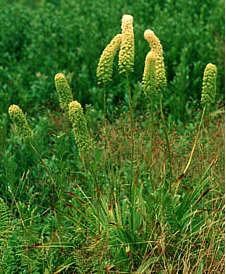
© Darel Hess - www.2bnthewild.com Scientific name: Amianthium muscaetoxicum (may also be found spelled as A. muscitoxicum) Description: Fly poison is a perennial plant with wide, grass-like basal leaves. Flowers areinitially white in color but later becoming green or red. The 3-petaled flowers (plus 3 sepals) are clustered in a dense raceme on top of a 1-3 foot tall leafless stalk. Flowers bloom mid-June through July in Shenandoah. Habitat: Fly poison is one of the first herbaceous species to emerge in early spring. It is typically found in dry to moist woods, meadows, and open fields. It is common throughout the In Common Names: Common names include fly poison, crow poison, stagger grass. The common name ¡°fly poison¡± is a literal translation of the Latin name ¡°muscaetoxicum¡± (muscae=flies, toxicum=poison) given the plant by Thomas Walter in 1788 when he published his wildflower book Flora Caroliniana. Other Facts: Although all parts of the plant contain toxins, the bulbs are the most toxic. The alkaloids in the plant act as neurotoxins commonly affect sheep and cattle when ingested. Other livestock can be affected as well, including goats and rabbits. Animals usually consume the plant only when other, more desirable, forage is unavailable, which can occur in early spring since fly poison leaves are some of the first to sprout. Cases of poisoning have been reported in the spring, summer, and fall. Affected animals will exhibit symptoms such as salivation and vomiting a few hours after ingestion. Later, the animal may experience weakness, lack of muscular coordination/staggering, and quick, labored respiration that dissipate within 1-2 days. Small hemorrhages may also be noticeable scattered throughout the skin. If the animal has ingested large amounts of the plant (¡Ý0.3% body weight of green plant for sheep and cattle), they may die from respiratory failure within the first day. No effective treatment is available to prevent death of effected animals; however, symptoms can be treated by keeping animals quiet, giving them sedatives, and administering gastric protectives by stomach tube. The Cherokee used the plant topically to stop itching. They also used the root to poison crows. Exploiting the bulb's toxicity, early American settlers ground the bulb into a paste and mixed it with sugar or honey to attract and kill flies. Fly poison is similar in appearance to two other North American wildflowers that are also in the Lily family. The eastern turkeybeard (Xerophyllum asphodeloides) can be found growing in the same areas as fly poison and has basal leaves and a long stalk bearing a plume of white flowers. However, turkeybeard has much narrower leaves and the flower cluster is typically more rounded. Bear grass (Xerophyllum tenax) is a Western relative of fly poison and turkeybeard and can be found throughout the meadows and woods from References and Links: Adkins, Leonard M. and Joe and Monica Cook. 1999. Wildflowers of the Alabama Cooperative Extension System. - Poisonous Plants of the Southeastern United States website University of Pennsylvania - Poisonous Plants of Pennsylvania websiteFurther information can be found: Integrated Taxonomic Information System (ITIS) Report U.S. Department of Agriculture. Germplasm Resource Information Network database which is sponsored by the Agricultural Research Service, U.S. Department of Agriculture. PLANTS National Database, a website supported by the Natural Resource Conservation Service. |
Last updated: February 26, 2015
